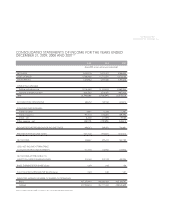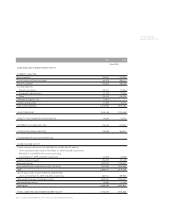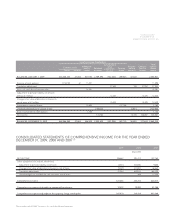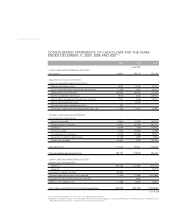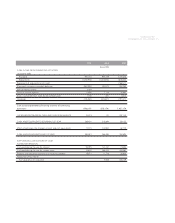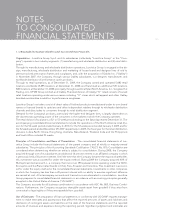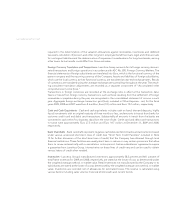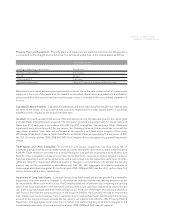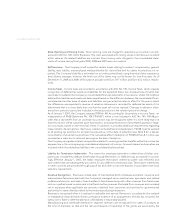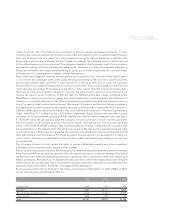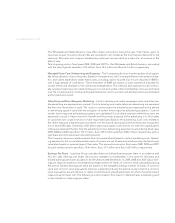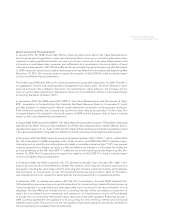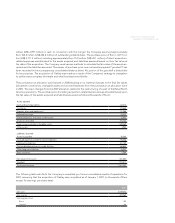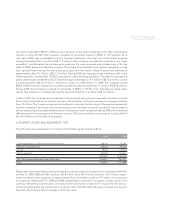LensCrafters 2009 Annual Report Download - page 63
Download and view the complete annual report
Please find page 63 of the 2009 LensCrafters annual report below. You can navigate through the pages in the report by either clicking on the pages listed below, or by using the keyword search tool below to find specific information within the annual report.
NOTES TO CONSOLIDATED
FINANCIAL STATEMENTS | 61 <
Property, Plant and Equipment - Property, plant and equipment are stated at historical cost. Depreciation
is computed on the straight-line method over the estimated useful lives of the related assets as follows:
Estimated useful life
Buildings and building improvements 19 to 40 years
Machinery and equipment 3 to 12 years
Aircraft 25 years
Other equipment 5 to 8 years
Leasehold improvements Lesser of 15 years or the remaining life of the lease
Maintenance and repair expenses are expensed as incurred. Upon the sale or disposition of property and
equipment, the cost of the asset and the related accumulated depreciation and leasehold amortization
are removed from the accounts and any resulting gain or loss is included in the consolidated statement of
income.
Capitalized Leased Property - Capitalized leased assets are amortized using the straight-line method over
the term of the lease, or in accordance with practices established for similar owned assets if ownership
transfers to the Company at the end of the lease term.
Goodwill - Goodwill represents the excess of the purchase price over the value assigned to the net tangible
and identifi able intangible assets acquired. The Company’s goodwill is tested annually for impairment as of
December 31 of each year in accordance with ASC No. 350, Intangibles - Goodwill and Other. Additional
impairment tests are performed if, for any reason, the Company believes that an event has occurred that
may impair goodwill. Such tests are performed at the reporting unit level which consists of four units,
Wholesale, Retail North America, Retail Asia-Pacifi c and Retail Other, as required by the provisions of ASC
No. 350. For the fi scal years 2009, 2008 and 2007, the Company did not recognize any goodwill impairment
charge.
Trade Names and Other Intangibles - In connection with various acquisitions, Luxottica Group has re-
corded as intangible assets certain trade names and other intangibles which the Company believes have a
fi nite life. Trade names are amortized on a straight-line basis over periods ranging from 20 to 25 years (see
Note 7). Other intangibles include, among other items, distributor networks, customer lists and contracts,
franchise agreements and license agreements, and are amortized over the respective useful lives. All intan-
gibles are tested for impairment whenever events or changes in circumstances indicate that the carrying
amount may not be recoverable in accordance with ASC No. 350. Aggregate amortization expense of
trade names and other intangibles for the fi scal years 2009, 2008 and 2007 was Euro 83.1 million, Euro 73.9
million and Euro 69.5 million, respectively.
Impairment of Long-Lived Assets - Luxottica Group’s long-lived assets, other than goodwill, are tested for
impairment whenever events or changes in circumstances indicate that the net carrying amount may not
be recoverable. When such events occur, the Company measures impairment by comparing the carrying
value of the long-lived asset to the estimated undiscounted future cash fl ows expected to result from the
use of the long-lived assets and their eventual disposition. If the sum of the expected undiscounted future
cash fl ows is less than the carrying amount of the long-lived assets, the Company records an impairment
loss, if determined to be necessary. Such impairment loss is measured as the amount by which the carrying
amount of the long-lived asset exceeds the fair value in accordance with ASC No. 360, Property, Plant &
Equipment. The aggregate impairment loss on certain non-performing long-lived assets charged to the
consolidated statements of income during fi scal years 2009, 2008 and 2007 was not material.


